This memorandum argues that the DEA's practice of obtaining Oregon patients' prescription records from the state's Prescription Drug Monitoring Program (PDMP) without a warrant violates the Fourth Amendment. It asserts that individuals have a reasonable expectation of privacy in their prescription records, as these records can reveal sensitive health information. The memorandum maintains that both case law and state statutes recognize privacy interests in medical information. It concludes that the DEA must obtain a judicial warrant supported by probable cause before accessing individuals' prescription records from the PDMP.
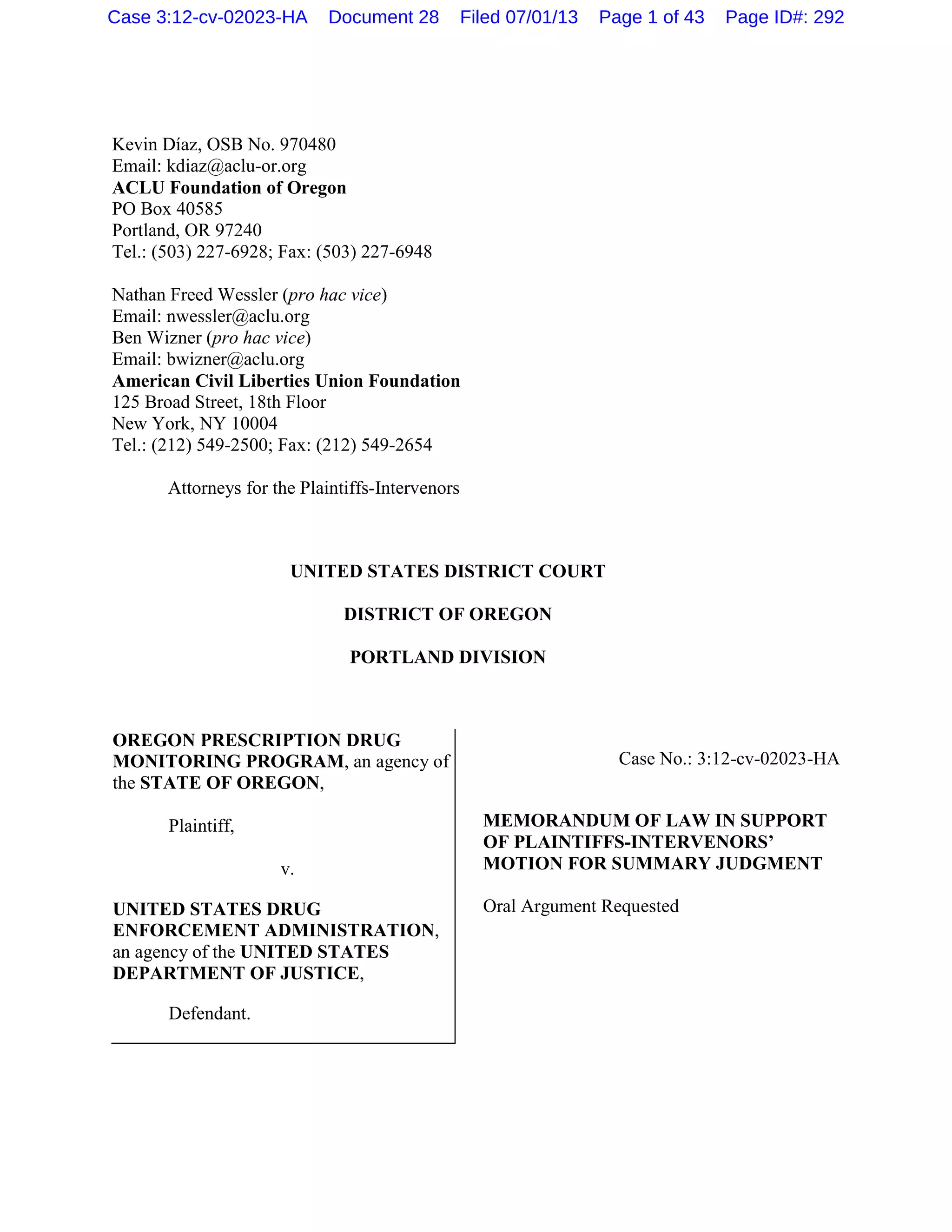
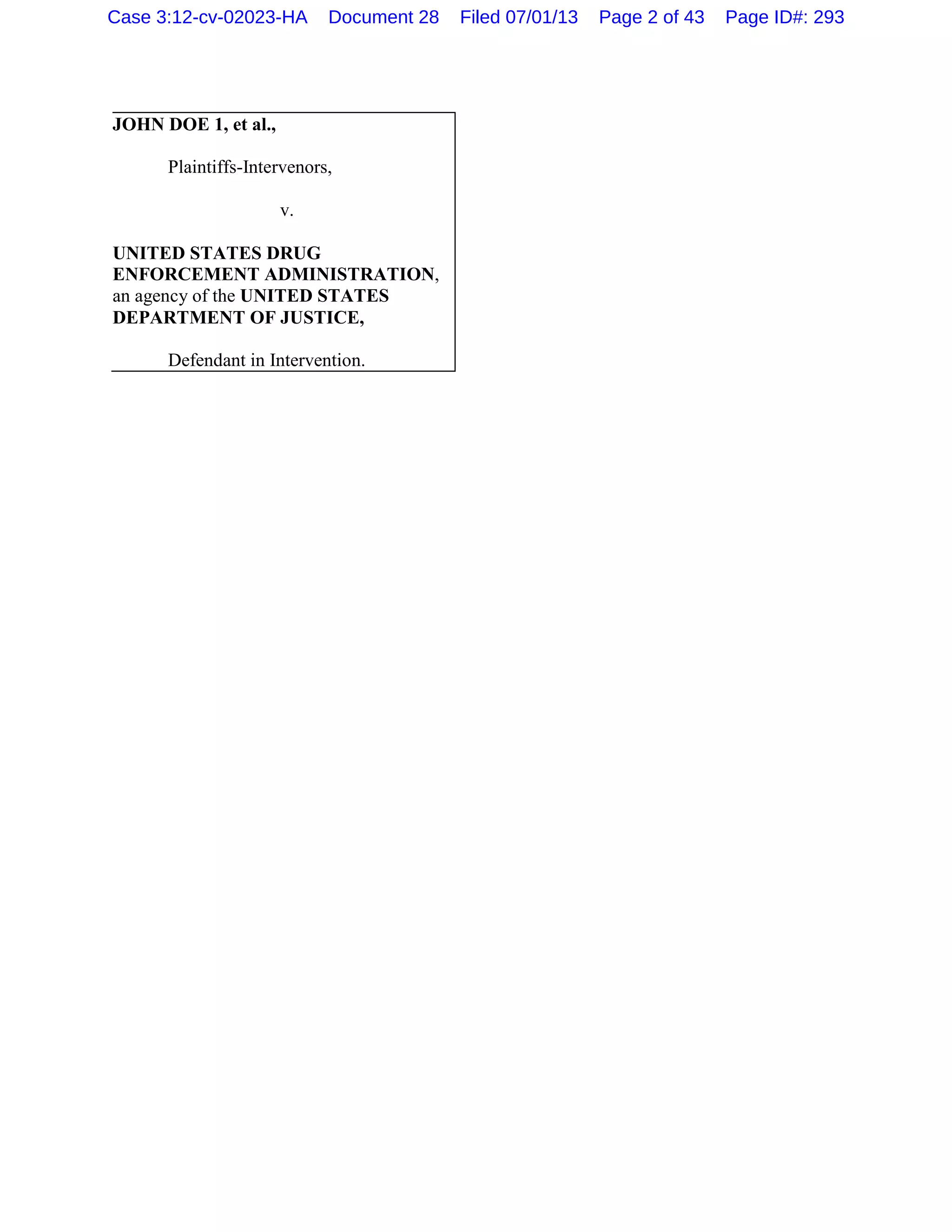


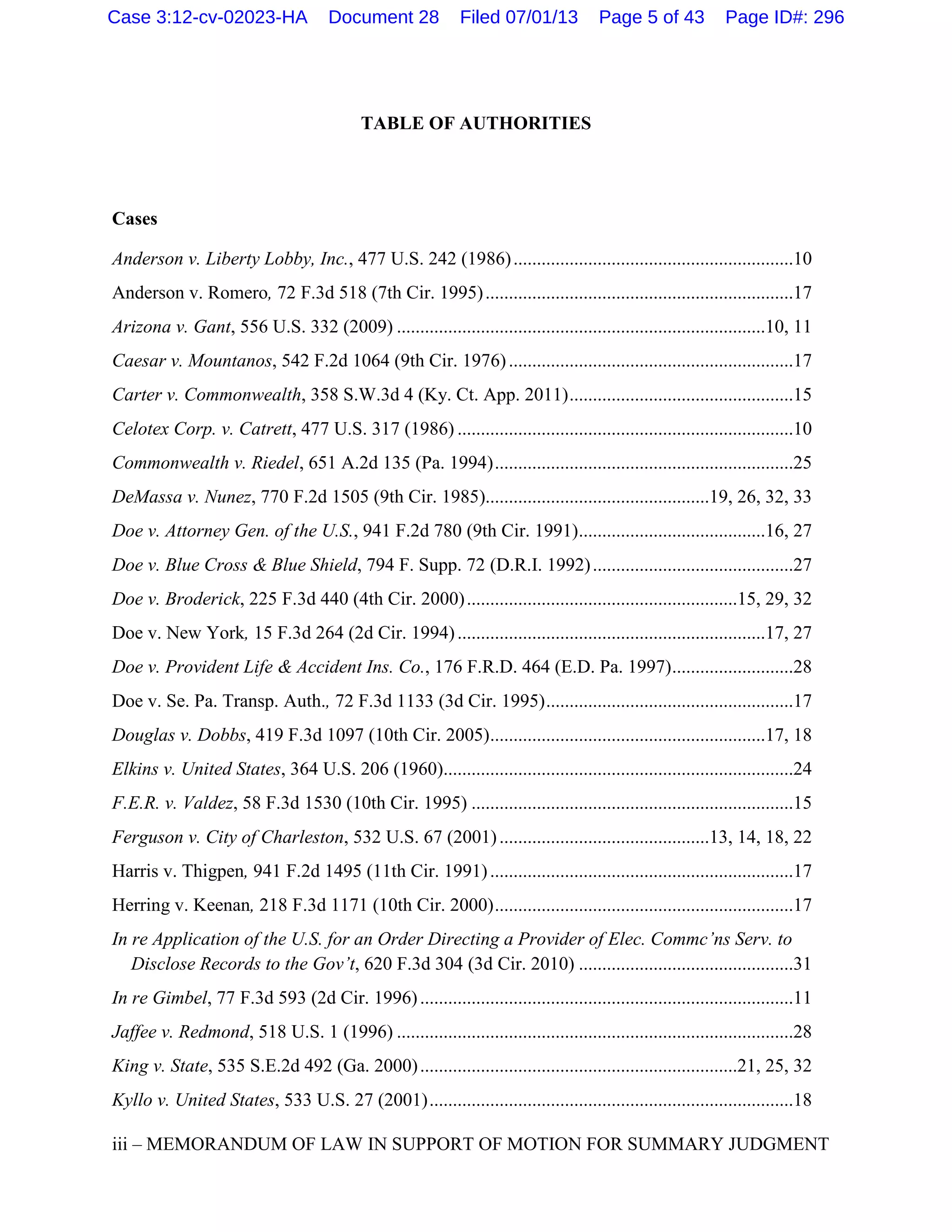


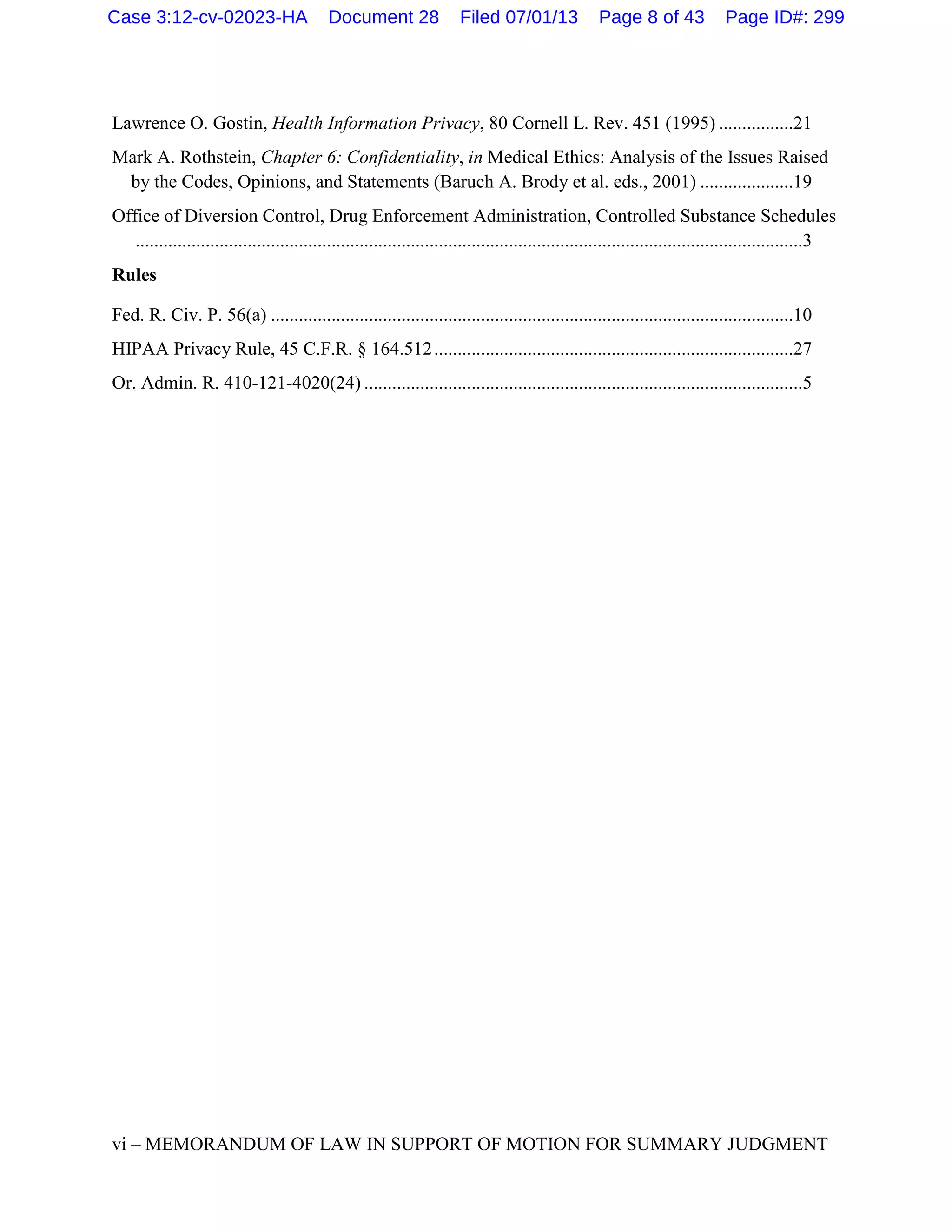
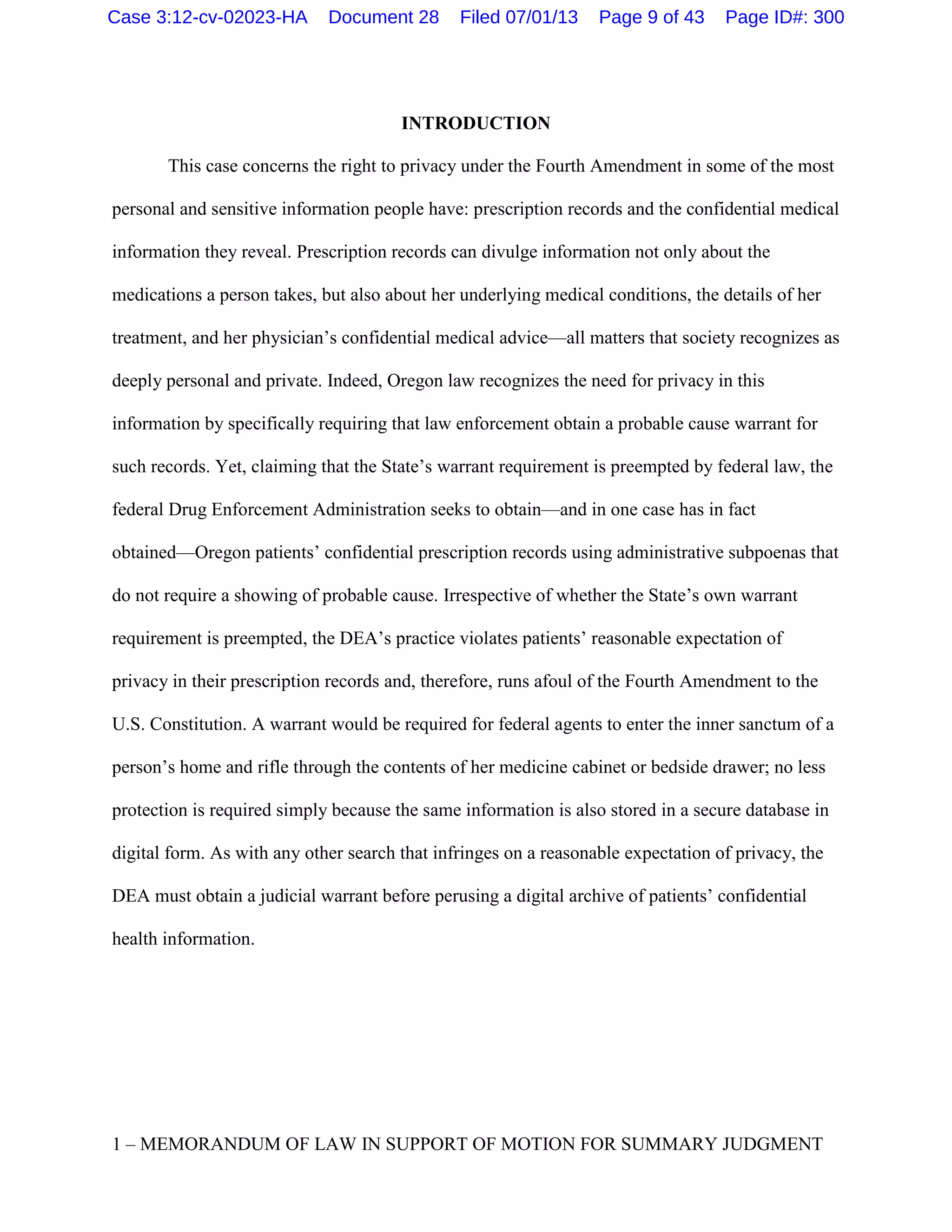

![the medicine they need. And with this registry that will help. I’m talking about eliminating
errors, eliminating cross medication.”); PDMP Fact Sheet, Wessler Decl. Ex. B (“The primary
purpose of the PDMP is to provide practitioners and pharmacists a tool to improve health care.”).
Thus, physicians and pharmacists may access patient records in the PDMP only if they “certif[y]
that the requested information is for the purpose of evaluating the need for or providing medical
or pharmaceutical treatment for a patient to whom the practitioner or pharmacist anticipates
providing, is providing or has provided care.” Or. Rev. Stat. § 431.966(2)(a)(A).
After dispensing a schedule II–IV prescription drug to a patient in Oregon, pharmacies
are required to electronically report to the PDMP the name, address, and date of birth of the
patient; identification of the pharmacy dispensing the drug and the practitioner who prescribed
the drug; and identification of the drug prescribed, date of origin of the prescription, date the
drug was dispensed, and quantity of the drug dispensed. Id. § 431.964(1).5
Approximately seven
million prescriptions are uploaded to the PDMP system annually, PDMP Fact Sheet, Wessler
Decl. Ex. B, and protected health information about identifiable patients is retained for up to
three years, Or. Rev. Stat. § 431.966(4).
The federal Controlled Substances Act, 21 U.S.C. § 812, creates five categories of drugs,
divided into schedules I–V. Schedule I drugs have “no currently accepted medical use in the
United States, a lack of accepted safety for use under medical supervision, and a high potential
for abuse,” and are not available for prescription. Office of Diversion Control, Drug Enforcement
Administration, Controlled Substance Schedules.6
Drugs are placed in schedules II–V based on
“their relative abuse potential, and likelihood of causing dependence when abused.” Id.; see also
5
New legislation, signed into law by the Oregon Governor on June 28, 2013 but not yet in force,
expands the categories of information reported to the PDMP. S.B. 470, § 3, 77th Leg. Assemb.
(Or. 2013).
6
http://www.deadiversion.usdoj.gov/schedules/#define.
3 – MEMORANDUM OF LAW IN SUPPORT OF MOTION FOR SUMMARY JUDGMENT
Case 3:12-cv-02023-HA Document 28 Filed 07/01/13 Page 11 of 43 Page ID#: 302](https://image.slidesharecdn.com/darrenchakeracluprivacy-160724182329/75/ACLU-Darren-Chaker-Privacy-11-2048.jpg)

![Anxiety disorders and other disorders with
symptoms of panic
Xanax, Valium, Ativan, Lexotan, Librium,
Traxene, Sepazon, Serax, Centrax,
nordiazepam
Alcohol addiction withdrawal symptoms Serax/Serenid-D, Librium (chlordiazepoxide)
Heroin addiction treatment methadone
Attention deficit hyperactivity disorder Ritalin, Adderol, Vyvanse
Obesity (weight loss drugs) Didrex, Voranil, Tenuate, mazindol
Chronic or acute pain narcotic painkillers, such as codeine (including
Tylenol with codeine), hydrocodone, Demerol,
morphine, Vicodin, oxycodone (including
Oxycontin and Percocet)
Epilepsy and seizure disorders Nembutal (pentobarbital), Seconal
(secobarbital), clobazam, clonazepam, Versed
Testosterone deficiency in men ethylestrenol (Maxibolin, Orabolin, Durabolin,
Duraboral)
Delayed puberty in boys Anadroid-F, Halotestin, Ora-Testryl
Narcolepsy Xyrem, Provigil
Insomnia Ambien, Lunesta, Sonata, Restoril, Halcion,
Doral, Ativan, ProSom, Versed
Migraines butorphanol (Stadol)
Because many of these drugs are approved only for treatment of specific medical
conditions, a prescription for a schedule II–IV drug will often reveal a patient’s underlying
medical condition. Peel Decl. ¶ 3; Decl. of Professor Mark A. Rothstein ¶ 10; Wessler Decl. Exs.
E–FF. Thus, information about an individual’s prescriptions in the PDMP can reveal a great deal
of sensitive medical information. In recognition of Oregon residents’ privacy interest in their
prescription records, the legislation creating the PDMP included privacy protections that sharply
limit access to personally identifiable prescription information in the database. See Or. Rev. Stat.
§ 431.966(2)(a). Relevant here, the PDMP is prohibited from disclosing prescription records to
law enforcement agencies unless presented with a “valid court order based on probable cause and
issued at the request of a federal, state or local law enforcement agency engaged in an authorized
drug-related investigation involving a person to whom the requested information pertains.” Id. §
431.966(2)(a)(C); see also Or. Admin. R. 410-121-4020(24) (“The [law enforcement] request
5 – MEMORANDUM OF LAW IN SUPPORT OF MOTION FOR SUMMARY JUDGMENT
Case 3:12-cv-02023-HA Document 28 Filed 07/01/13 Page 13 of 43 Page ID#: 304](https://image.slidesharecdn.com/darrenchakeracluprivacy-160724182329/75/ACLU-Darren-Chaker-Privacy-13-2048.jpg)
![shall be pursuant to a valid court order based on probable cause.”). The Oregon Health
Authority, the state agency that administers the PDMP, prominently and repeatedly explains this
protection on the Oregon PDMP website. See Oregon Health Authority, Data Requests,9
Wessler
Decl. Ex. GG (“[Law enforcement may] gather information for an active drug-related
investigation of an individual when permitted by a valid court order based on probable cause.”);
Oregon Health Authority, Law Enforcement,10
Wessler Decl. Ex. HH (“A subpoena is not
sufficient for the PDMP to release information. A law enforcement agency must provide a search
warrant signed by a judge or a court order signed by a judge that indicates there is probable cause
for the judge to issue the order.”); Oregon Health Authority, Frequently Asked Questions,11
Wessler Decl. Ex A (“Law enforcement agencies will not have direct access to the system, but
law enforcement officials may request information from the Oregon Health Authority if they
have a valid court order based on probable cause for an authorized drug-related investigation of
an individual.”).
II. DEA Warrantless Requests to the PDMP
Notwithstanding the requirement of a court order based on probable cause under Oregon
law, the Drug Enforcement Administration (“DEA”) has been attempting to obtain protected
health information from the PDMP using administrative subpoenas pursuant to 21 U.S.C. § 876.
E.g., Petition to Enforce DEA Administrative Subpoena, United States v. State of Oregon
Prescription Drug Monitoring Program (hereinafter “U.S. v. Oregon PDMP”), No. 12-MC-298
(D. Or. Aug. 24, 2012), Wessler Decl. Ex. II; see also Decl. of Nina Englander in Support of
Motion for Summary Judgment ¶¶ 2–7, ECF No. 26. Section 876 permits certain federal law
9
http://www.orpdmp.com/data-requests/.
10
http://www.orpdmp.com/law-enforcement/.
11
http://www.orpdmp.com/faq.html.
6 – MEMORANDUM OF LAW IN SUPPORT OF MOTION FOR SUMMARY JUDGMENT
Case 3:12-cv-02023-HA Document 28 Filed 07/01/13 Page 14 of 43 Page ID#: 305](https://image.slidesharecdn.com/darrenchakeracluprivacy-160724182329/75/ACLU-Darren-Chaker-Privacy-14-2048.jpg)
![enforcement officials to issue and serve subpoenas seeking records “relevant or material” to a
controlled substances investigation. 21 U.S.C. § 876(a). The subpoenas are issued without first
being presented to a court, but are judicially enforceable if the recipient declines to honor them.
Id. § 876(c). The DEA has issued multiple § 876 subpoenas to the PDMP, and has stated that it
will issue approximately two subpoenas to the PDMP per month for the foreseeable future.
Declaration of Lori A. Cassity In Support of Petition to Enforce DEA Administrative Subpoena ¶
6, U.S. v. Oregon PDMP, No. 12-MC-298 (D. Or. Aug. 24, 2012), Wessler Decl. Ex. JJ;
Englander Decl. ¶¶ 2, 4–5.
The State of Oregon has refused to comply with the DEA subpoenas on the basis that
complying with them would violate Oregon law. See Englander Decl. ¶¶ 6–7 & Exs. E–F. The
DEA takes the position that the Oregon requirement of a court order based on probable cause is
preempted by § 876. Memorandum in Support of Petition to Enforce DEA Administrative
Subpoena, U.S. v. Oregon PDMP, No. 12-MC-298 (D. Or. Aug. 24, 2012), Wessler Decl. Ex.
KK. The DEA has obtained judicial enforcement of at least one subpoena. That subpoena, issued
on January 5, 2012, sought production of “a Physician Profile for all Schedule II-V controlled
substance prescriptions written by [a specific doctor, whose name is redacted from public filings]
from 6/01/2011 through 1/06/2012.” Id. at 2. In its petition to enforce the subpoena, the DEA
specifically stated that redacted protected health information could not reasonably be used in the
investigation, and therefore that it was seeking the names and other identifying information of
individual patients who filled prescriptions written by the doctor under investigation. Declaration
of Tyler D. Warner in Support of Petition to Enforce DEA Administrative Subpoena ¶ 6, U.S. v.
Oregon PDMP, No. 12-MC-298 (D. Or. Aug. 24, 2012), Wessler Decl. Ex. LL. On August 27,
2012, a magistrate judge in the District of Oregon granted the DEA’s petition to enforce the
7 – MEMORANDUM OF LAW IN SUPPORT OF MOTION FOR SUMMARY JUDGMENT
Case 3:12-cv-02023-HA Document 28 Filed 07/01/13 Page 15 of 43 Page ID#: 306](https://image.slidesharecdn.com/darrenchakeracluprivacy-160724182329/75/ACLU-Darren-Chaker-Privacy-15-2048.jpg)



![applies, may government officials conduct a warrantless search. Id. (internal quotation marks
omitted). Accordingly, the government may use an administrative subpoena to conduct a search
only if the target of the search lacks a reasonable expectation of privacy in the requested records.
United States v. Plunk, 153 F.3d 1011, 1020 (9th Cir. 1998) (“Plunk does not have the requisite
standing to challenge [the subpoena’s] issuance under the Fourth Amendment ‘unless he [can]
demonstrate that he had a legitimate expectation of privacy attaching to the records obtained.’”
(second alteration in original)), amended by 161 F.3d 1195 (9th Cir. 1998), abrogated on other
grounds by United States v. Hankey, 203 F.3d 1160, 1169 & n.7 (9th Cir. 2000); see also, e.g., In
re Gimbel, 77 F.3d 593, 599 (2d Cir. 1996) (stating that the Fourth Amendment bars use of an
administrative subpoena when “a subpoena respondent maintains a reasonable expectation of
privacy in the materials sought by the subpoena”). The Ninth Circuit has therefore permitted use
of administrative subpoenas only after determining that the target of the investigation lacked a
reasonable expectation of privacy in the items or records law enforcement seeks. E.g., United
States v. Golden Valley Elec. Ass’n, 689 F.3d 1108, 1116 (9th Cir. 2012); Plunk, 153 F.3d at
1020.
B. Plaintiffs-Intervenors Have a Reasonable Expectation of Privacy in their Prescription
Records Held by the PDMP.
To establish a reasonable expectation of privacy under the Fourth Amendment, a litigant
must demonstrate an actual expectation of privacy in the item or location searched, and that the
expectation of privacy is “one that society is prepared to recognize as reasonable.” Smith v.
Maryland, 442 U.S. 735, 740 (1979) (internal quotation marks omitted). A reasonable
expectation of privacy is “one that has ‘a source outside of the Fourth Amendment, either by
reference to concepts of real or personal property law or to understandings that are recognized
11 – MEMORANDUM OF LAW IN SUPPORT OF MOTION FOR SUMMARY JUDGMENT
Case 3:12-cv-02023-HA Document 28 Filed 07/01/13 Page 19 of 43 Page ID#: 310](https://image.slidesharecdn.com/darrenchakeracluprivacy-160724182329/75/ACLU-Darren-Chaker-Privacy-19-2048.jpg)
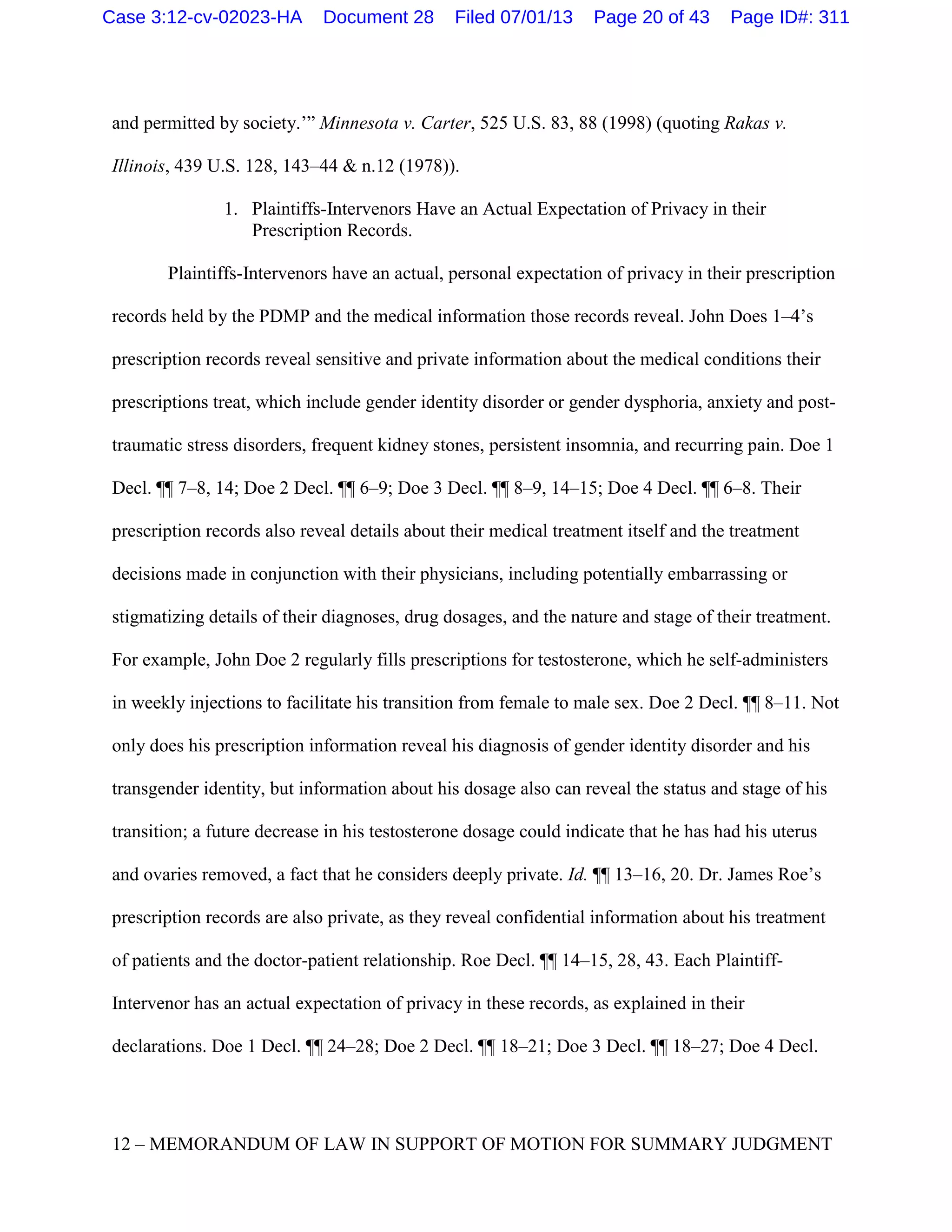
![¶¶ 12–19; Roe Decl. ¶ 43; see also Peel Decl. ¶ 16 (“[I]nformation about Plaintiffs-Intervenors’
prescriptions reveals sensitive details of their diagnoses.”).
2. Society Recognizes the Expectation of Privacy in Prescription Records as
Reasonable.
Prescription records reveal intimate, private, and potentially stigmatizing details about a
patient’s health, including the patient’s underlying medical condition, the severity of the
condition, and the course of treatment prescribed by the treating physician. Peel Decl. ¶¶ 3, 17.
For that reason, as with other medical records, they are widely considered private—and
reasonably so.
Under the Fourth Amendment, there is “no talisman that determines in all cases those
privacy expectations that society is prepared to accept as reasonable.” O’Connor v. Ortega, 480
U.S. 709, 715 (1987) (plurality opinion). “Instead, ‘the Court has given weight to such factors as
the intention of the Framers of the Fourth Amendment, the uses to which the individual has put a
location, and our societal understanding that certain areas deserve the most scrupulous protection
from government invasion.’” Id. (quoting Oliver v. United States, 466 U.S. 170, 178 (1984)).
Warrantless access to confidential medical records trenches on privacy expectations recognized
by case law, states’ practices, and longstanding principles of medical ethics known to the Fourth
Amendment’s framers and relied on by the public today. Therefore, the DEA’s use of
administrative subpoenas to obtain records in the PDMP violates the Fourth Amendment.
i. Case law recognizes an expectation of privacy in medical information.
In Ferguson v. City of Charleston, 532 U.S. 67 (2001), the Supreme Court held that
patients have a reasonable expectation of privacy in their medical records. The case addressed
whether the “special needs” exception to the Fourth Amendment provides a state hospital with
“authority to conduct drug tests [of patients] and to turn the results over to law enforcement
13 – MEMORANDUM OF LAW IN SUPPORT OF MOTION FOR SUMMARY JUDGMENT
Case 3:12-cv-02023-HA Document 28 Filed 07/01/13 Page 21 of 43 Page ID#: 312](https://image.slidesharecdn.com/darrenchakeracluprivacy-160724182329/75/ACLU-Darren-Chaker-Privacy-21-2048.jpg)
![agents without the knowledge or consent of the patients.” Id. at 77. Before concluding that the
special needs exception did not apply—and thus that the hospital had violated the Fourth
Amendment—the Court held that “[t]he reasonable expectation of privacy enjoyed by the typical
patient undergoing diagnostic tests in a hospital is that the results of those tests will not be shared
with nonmedical personnel without her consent.” Id. at 78. The Court apparently found that
principle an easy one, remarking that “in none of our prior cases was there any intrusion upon
that kind of expectation” and that “we have previously recognized that an intrusion on that
expectation may have adverse consequences because it may deter patients from receiving needed
medical care.” Id. at 78 & n.14. Although the Court has not addressed the privacy interest under
the Fourth Amendment in prescription records in particular, its reasoning in Ferguson applies
with equal force to medical records beyond diagnostic test results, including confidential
prescription information that can reveal just as much about an underlying diagnosis as can the
test results themselves.
The Ninth Circuit, too, has recognized that patients and doctors have a reasonable
expectation of privacy in medical records under the Fourth Amendment. Thus, in Tucson
Woman’s Clinic v. Eden, 379 F.3d 531, 550 (9th Cir. 2004), the court held that a warrant is
required for law enforcement to search medical records held by an abortion clinic, in part
because “all provision of medical services in private physicians’ offices carries with it a high
expectation of privacy for both physician and patient.” Other courts have echoed this conclusion.
See, e.g., State v. Skinner, 10 So. 3d 1212, 1218 (La. 2009) (“[W]e find that the right to privacy
in one’s medical and prescription records is an expectation of privacy that society is prepared to
recognize as reasonable. Therefore, absent the narrowly drawn exceptions permitting warrantless
searches, we hold a warrant is required to conduct an investigatory search of medical and/or
14 – MEMORANDUM OF LAW IN SUPPORT OF MOTION FOR SUMMARY JUDGMENT
Case 3:12-cv-02023-HA Document 28 Filed 07/01/13 Page 22 of 43 Page ID#: 313](https://image.slidesharecdn.com/darrenchakeracluprivacy-160724182329/75/ACLU-Darren-Chaker-Privacy-22-2048.jpg)
![prescription records.”); Doe v. Broderick, 225 F.3d 440, 450–51 (4th Cir. 2000) (“[A] patient’s
expectation of privacy . . . in his treatment records and files maintained by a substance abuse
treatment center is one that society is willing to recognize as objectively reasonable.”); Nat’l
Assoc. of Letter Carriers, AFL-CIO v. U.S. Postal Serv., 604 F. Supp. 2d 665, 674–75 (S.D.N.Y.
2009) (holding that postal employees whose medical information was obtained from health care
providers by the Postal Service without consent “have—at a minimum—standing to bring suit
based on a reasonable expectation of privacy in their medical records”); see also F.E.R. v.
Valdez, 58 F.3d 1530, 1535 (10th Cir. 1995) (noting that the patient-plaintiffs “had an
expectation of privacy in their medical records” and upholding search pursuant to a facially valid
warrant).13
One source of the expectation of privacy in medical information and prescription records
can be found in cases addressing the right to informational privacy under the Due Process
clauses of the Fifth and Fourteenth Amendments. Those cases—more numerous than the cases
addressing medical records under the Fourth Amendment—speak to the widespread acceptance,
and thus the reasonableness, of privacy protections for medical records. The foundational case is
Whalen v. Roe, 429 U.S. 589 (1977). There the Supreme Court considered whether New York’s
collection of prescription records in an early computerized database violated patients’ and
13
Some courts have held that there is no reasonable expectation of privacy in prescription
records under the Fourth Amendment, relying on the “third party doctrine.” See Williams v.
Commonwealth, 213 S.W. 3d 671, 682–84 (Ky. 2006). That reasoning has come under
significant criticism, and is inapt here. See, e.g., Carter v. Commonwealth, 358 S.W.3d 4, 8–9
(Ky. Ct. App. 2011) (explaining strong disagreement with reasoning of Williams and imposing
reasonable suspicion standard for requests for prescription records); see also infra Part III
(explaining why third party doctrine does not apply in this case). Courts have also applied the
“pervasively regulated industry” exception to the Fourth Amendment in permitting inspections
of pharmacy records. See, e.g., State v. Russo, 790 A.2d 1132, 1151–52 (Conn. 2002); Stone v.
Stow, 593 N.E. 2d 294, 300–01 (Ohio 1992). Those cases are inapposite because they authorize
inspections of individual pharmacies, not searches of all of a patient’s or physician’s prescription
records in a comprehensive statewide electronic database maintained by a state agency.
15 – MEMORANDUM OF LAW IN SUPPORT OF MOTION FOR SUMMARY JUDGMENT
Case 3:12-cv-02023-HA Document 28 Filed 07/01/13 Page 23 of 43 Page ID#: 314](https://image.slidesharecdn.com/darrenchakeracluprivacy-160724182329/75/ACLU-Darren-Chaker-Privacy-23-2048.jpg)
![doctors’ right to informational privacy. Although the Court held that the security and privacy
protections of New York’s system made it constitutionally permissible, it recognized a right to
informational privacy and explained that the right “involved at least two different kinds of
interests. One is the individual interest in avoiding disclosure of personal matters, and another is
the interest in independence in making certain kinds of important decisions.” Id. at 599–600. The
Court explained how collection of prescription records implicates both factors:
The mere existence in readily available form of the information about patients’
use of Schedule II drugs creates a genuine concern that the information will
become publicly known and that it will adversely affect their reputations. This
concern makes some patients reluctant to use, and some doctors reluctant to
prescribe, such drugs even when their use is medically indicated. It follows,
[plaintiffs] argue, that the making of decisions about matters vital to the care of
their health is inevitably affected by the statute. Thus, the statute threatens to
impair both their interest in the nondisclosure of private information and also their
interest in making important decisions independently.
Id. at 600.14
The Ninth Circuit has significantly expanded on the Supreme Court’s discussion in
Whalen, firmly and repeatedly recognizing the “privacy protection afforded medical
information.” Doe v. Attorney Gen. of the U.S., 941 F.2d 780, 795–96 (9th Cir. 1991), vacated on
other grounds sub nom. Reno v. Doe ex rel. Lavery, 518 U.S. 1014 (1996). The court has
explained that “[o]ne can think of few subject areas more personal and more likely to implicate
privacy interests than that of one’s health,” and has stated that collection of medical information
“implicate[s] rights protected under both the Fourth Amendment and the Due Process Clause[s].”
Norman-Bloodsaw v. Lawrence Berkeley Lab., 135 F.3d 1260, 1269 (9th Cir. 1998); see also
Seaton v. Mayberg, 610 F.3d 530, 541 (9th Cir. 2010) (“One who goes to a physician in order to
14
In Whalen, the Court expressly declined to address application of the Fourth Amendment to
searches of medical records because the facts of the case did not involve any of the “affirmative,
unannounced, narrowly focused intrusions into individual privacy during the course of criminal
investigations” at issue in prior Fourth Amendment cases. Id. at 604 n.32.
16 – MEMORANDUM OF LAW IN SUPPORT OF MOTION FOR SUMMARY JUDGMENT
Case 3:12-cv-02023-HA Document 28 Filed 07/01/13 Page 24 of 43 Page ID#: 315](https://image.slidesharecdn.com/darrenchakeracluprivacy-160724182329/75/ACLU-Darren-Chaker-Privacy-24-2048.jpg)
![obtain medical benefit to himself or his family has substantial privacy interests . . . .”); Tucson
Woman’s Clinic, 379 F.3d at 551 (“Individuals have a constitutionally protected interest in
avoiding ‘disclosure of personal matters,’ including medical information.”); Yin v. California, 95
F.3d 864, 870 (9th Cir. 1996) (“[I]ndividuals have a right protected under the Due Process
Clause of the Fifth or Fourteenth Amendments in the privacy of personal medical information
and records.”); Caesar v. Mountanos, 542 F.2d 1064, 1067 n.9 (9th Cir. 1976) (recognizing “the
right of privacy encompassing the doctor-patient relationship”). Other circuits to address the
issue agree. Herring v. Keenan, 218 F.3d 1171, 1175 (10th Cir. 2000); Doe v. Se. Pa. Transp.
Auth., 72 F.3d 1133, 1137 (3d Cir. 1995); Anderson v. Romero, 72 F.3d 518, 522 (7th Cir. 1995);
Doe v. New York, 15 F.3d 264, 267 (2d Cir. 1994); see also Harris v. Thigpen, 941 F.2d 1495,
1513 (11th Cir. 1991) (assuming such right exists). Cf. Lee v. City of Columbus, Ohio, 636 F.3d
245, 260–61 (6th Cir. 2011) (recognizing privacy interest in medical records but stating that “‘a
person possesses no reasonable expectation that his medical history will remain completely
confidential’”).
Further, two circuits have specifically held that the right to privacy in medical
information encompasses prescription records. As the Third Circuit explained,
It is now possible from looking at an individual’s prescription records to
determine that person’s illnesses, or even to ascertain such private facts as
whether a woman is attempting to conceive a child through the use of fertility
drugs. This information is precisely the sort intended to be protected by
penumbras of privacy. An individual using prescription drugs has a right to expect
that such information will customarily remain private.
Se. Pa. Transp. Auth., 72 F.3d at 1138 (citation omitted); accord Douglas v. Dobbs, 419 F.3d
1097, 1102 (10th Cir. 2005) (“[W]e have no difficulty concluding that protection of a right to
privacy in a person’s prescription drug records, which contain intimate facts of a personal nature,
is sufficiently similar to other areas already protected within the ambit of privacy. Information
17 – MEMORANDUM OF LAW IN SUPPORT OF MOTION FOR SUMMARY JUDGMENT
Case 3:12-cv-02023-HA Document 28 Filed 07/01/13 Page 25 of 43 Page ID#: 316](https://image.slidesharecdn.com/darrenchakeracluprivacy-160724182329/75/ACLU-Darren-Chaker-Privacy-25-2048.jpg)
![contained in prescription records . . . may reveal other facts about what illnesses a person
has . . . .”).
Courts have also recognized that physicians, in addition to patients, have an interest in the
privacy of their prescription and other medical records. The Supreme Court recently noted: “It
may be assumed that, for many reasons, physicians have an interest in keeping their prescription
decisions confidential.” Sorrell v. IMS Health Inc., 131 S. Ct. 2653, 2668 (2011); see also
Whalen, 429 U.S. at 600 (explaining concern that risk of privacy violations make “some doctors
reluctant to prescribe . . . drugs even when their use is medically indicated”).
These cases protecting the privacy of medical information under the Fifth and Fourteenth
Amendments provide a source for the societal expectation of privacy in prescription records and
the medical information they reveal, and thus a basis for triggering the Fourth Amendment’s
protections. See Douglas, 419 F.3d at 1101–03 (relying on Whalen and related cases to inform
analysis of Fourth Amendment interest in privacy of prescription records). Because “few subject
areas [are] more personal and more likely to implicate privacy interests than that of one’s
health,” Norman-Bloodsaw, 135 F.3d at 1269, patients have a reasonable expectation of privacy
in their medical information.15
The Supreme Court and Ninth Circuit have recognized as much.
Ferguson, 532 U.S. at 78; Tucson Woman’s Clinic, 379 F.3d at 550.
ii. The confidentiality of patient health information is protected by
longstanding ethical rules that were known to the framers of the Fourth
Amendment and continue in force today.
15
Prescription records reveal some medical information (the drugs and dosages a person takes)
directly and other information (a patient’s underlying medical conditions) by inference. A search
can implicate the Fourth Amendment regardless of whether it reveals information directly or
through inference. See Kyllo v. United States, 533 U.S. 27, 36 (2001) (rejecting “the novel
proposition that inference insulates a search,” noting that it was “blatantly contrary” to the
Court’s holding in United States v. Karo, 468 U.S. 705 (1984), “where the police ‘inferred’ from
the activation of a beeper that a certain can of ether was in the home”).
18 – MEMORANDUM OF LAW IN SUPPORT OF MOTION FOR SUMMARY JUDGMENT
Case 3:12-cv-02023-HA Document 28 Filed 07/01/13 Page 26 of 43 Page ID#: 317](https://image.slidesharecdn.com/darrenchakeracluprivacy-160724182329/75/ACLU-Darren-Chaker-Privacy-26-2048.jpg)


![apothecary or compounding pharmacist. Id. ¶ 18. Like George Washington, who was treated by
Edinburgh-educated physician Samuel Bard, most of the delegates to the Constitutional
Convention would have had access to the services of such physicians, who practiced in
significant numbers in the population centers of the late-18th century United States. Id. ¶ 5. The
delegates thus would have expected their own medical information to have been protected
against release to third parties without their consent. Id. ¶¶ 5, 18. Thus, ethical protections of the
confidentiality of medical information were firmly in place at the time of the Fourth
Amendment’s ratification in 1791 and were known to the Constitution’s framers.
The strong and enduring guarantees of the confidentiality of patients’ medical
information are “essential in encouraging patients to provide their physicians with accurate and
complete health information, without which medical care would be severely compromised.”
Rothstein Decl. ¶ 4. Without confidentiality protections, patients would “delay medical care or
avoid treatment altogether” and suffer embarrassment, stigma, and economic harms. Id. ¶¶ 5–6.
A lack of confidentiality protections can also lead to public health consequences and “can lessen
societal support for the health care system.” Id. ¶¶ 7–8; see also Lawrence O. Gostin, Health
Information Privacy, 80 Cornell L. Rev. 451, 490–91 (1995) (explaining why protecting the
confidentiality of patients’ medical information “is valued not only to protect patients’ social and
economic interests, but also their health and the health of the wider community”).
The consequences of law enforcement gaining easy access to medical records are
particularly harmful. As one court has explained, “[p]ermitting the State unlimited access to
medical records for the purposes of prosecuting the patient would have the highly oppressive
effect of chilling the decision of any and all [persons] to seek medical treatment.” King v. State,
535 S.E.2d 492, 496 (Ga. 2000). The Supreme Court has echoed this concern, recognizing that
21 – MEMORANDUM OF LAW IN SUPPORT OF MOTION FOR SUMMARY JUDGMENT
Case 3:12-cv-02023-HA Document 28 Filed 07/01/13 Page 29 of 43 Page ID#: 320](https://image.slidesharecdn.com/darrenchakeracluprivacy-160724182329/75/ACLU-Darren-Chaker-Privacy-29-2048.jpg)
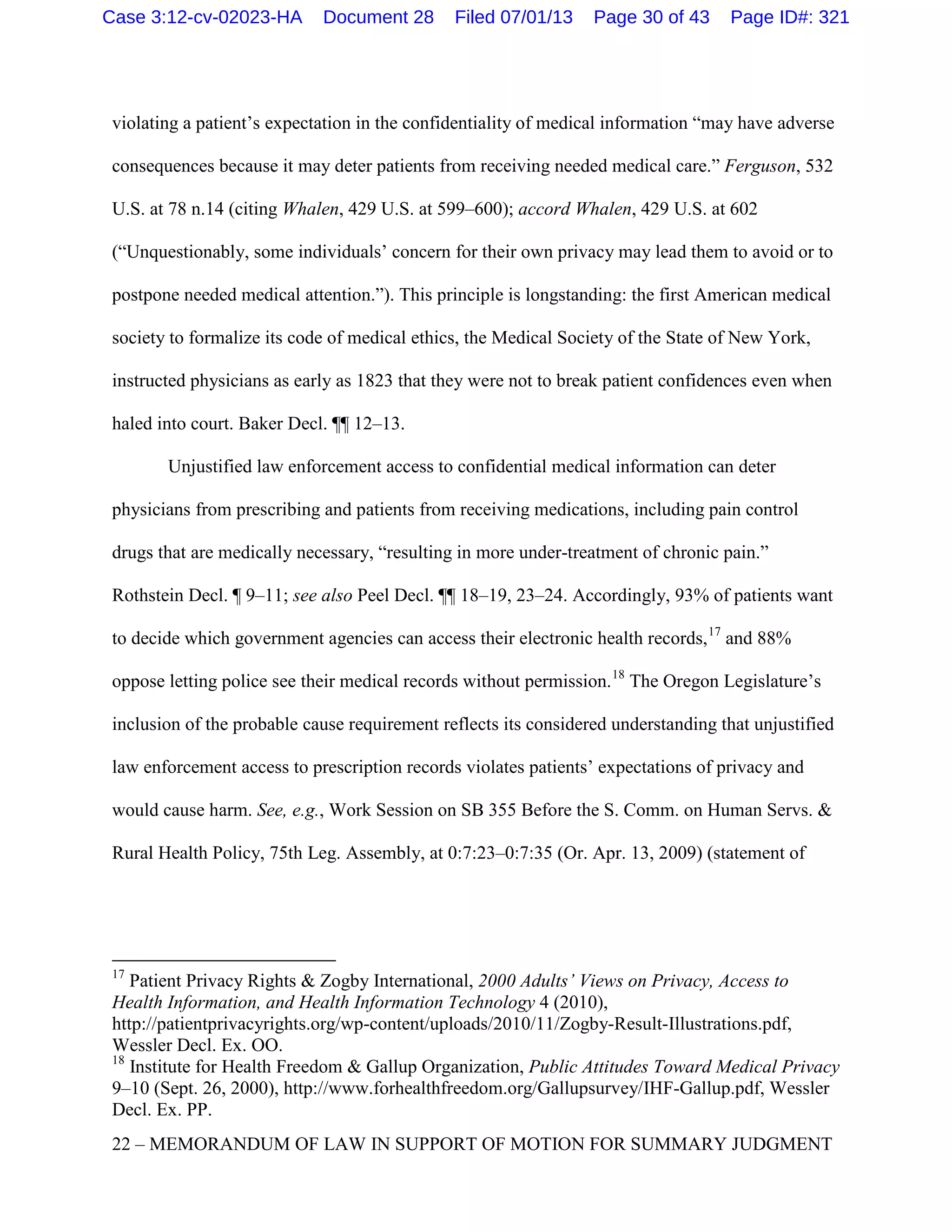


![analysis. See Garner, 471 U.S. at 18 (“It cannot be said that there is a constant or overwhelming
trend away from the common-law rule. . . . Nonetheless, the long-term movement has been away
from the rule that deadly force may be used against any fleeing felon, and that remains the rule in
less than half the States.”). The nine states that require probable cause all have adopted or
reasserted this standard within the last decade. And of the seven states to enact or update
prescription drug monitoring statutes in the last two years, four require probable cause for law
enforcement access and one makes no provision for law enforcement access at all. Compare
2012 N.H. Adv. Legis. Serv. 196 (LexisNexis), 2011 Ga. Laws 659, § 2, 2011 Mont. Laws ch.
241, § 7 (relevant terms defined in Mont. Code Ann. § 46-4-301(3)), 2011 Neb. Laws 237, and
2011 Ark. Acts 304, with 2011 Md. Laws 166 and 2011 Tenn. Pub. Acts 310, § 3. Thus, the
trend in the states is toward adoption of greater protections against unjustified law enforcement
access.
Additionally, a number of state courts have held that individuals have a reasonable
expectation of privacy in medical records under state constitutional provisions or the Fourth
Amendment. See State v. Skinner, 10 So. 3d 1212, 1218 (La. 2009) (“[A]bsent the narrowly
drawn exceptions permitting warrantless searches, we hold a warrant is required to conduct an
investigatory search of medical and/or prescription records.”); King v. State, 535 S.E.2d 492, 495
(Ga. 2000) (“[A] patient’s medical information, as reflected in the records maintained by his or
her medical providers, is certainly a matter which a reasonable person would consider to be
private.”); State v. Nelson, 941 P.2d 441, 449 (Mont. 1997) (“We hold that in order to establish
that there is a compelling state interest for the issuance of an investigative subpoena for the
discovery of medical records, the State must show probable cause . . . .”); Commonwealth v.
Riedel, 651 A.2d 135, 139–40 (Pa. 1994) (holding that probable cause is required for access to
25 – MEMORANDUM OF LAW IN SUPPORT OF MOTION FOR SUMMARY JUDGMENT
Case 3:12-cv-02023-HA Document 28 Filed 07/01/13 Page 33 of 43 Page ID#: 324](https://image.slidesharecdn.com/darrenchakeracluprivacy-160724182329/75/ACLU-Darren-Chaker-Privacy-33-2048.jpg)
![medical records because “appellant does have a reasonable expectation of privacy in his medical
records”); State v. Copeland, 680 S.W.2d 327, 330–31 (Mo. Ct. App. 1984) (requiring probable
cause for the results of blood tests because, “[f]ollowing the law and common practice, it is
normally expected that a patient’s disclosures to a hospital will be kept confidential”).
Further, a majority of states recognize a physician-patient privilege as a matter of state
law. No physician-patient privilege existed at common law, but 42 states and the District of
Columbia have created one through legislation.23
These privileges, like the other state privacy
protections discussed above, function to assure patients of the confidentiality of their medical
information and form part of the basis upon which patients’ expectations of privacy are formed.
Cf. DeMassa v. Nunez, 770 F.2d 1505, 1506 (9th Cir. 1985) (per curiam) (discussing attorney-
client privilege as a source of clients’ reasonable expectation of privacy in their client files held
by an attorney).24
23
Alaska R. Evid. 504; Ariz. Rev. Stat. Ann. § 12-2235 (2013); Ark. R. Evid. 503; Cal. Evid.
Code §§ 990–1007 (West 2013); Colo. Rev. Stat. § 13-90-107(d) (2013); Conn. Gen. Stat. Ann.
§ 52-146o (West 2013); Del. Unif. R. Evid. 503; D.C. Code Ann. § 14-307 (2013); Fla. Stat.
Ann. § 456.057 (West 2013); Haw. Rev. Stat. § 616-1 (West 2013); Idaho Code Ann. § 9-203.4
(West 2013); 735 Ill. Comp. Stat. Ann. 5/8-802 (West 2013); Ind. Code Ann. § 34-46-3-1 (West
2013); Iowa Code Ann. § 622.10 (West 2013); Kan. Stat. Ann. § 60-427 (West 2012); La. Code
Evid. Ann. art. 510 (2012); Me. R. Evid. 503; Mich. Comp. Laws Ann. § 600.2157 (West 2013);
Minn. Stat. Ann. § 595.02 (West 2013); Miss. Code Ann. § 13-1-21 (West 2013); Mo. Ann. Stat.
§ 491.060 (West 2013); Mont. Code Ann. § 26-1-805 (West 2013); Neb. Rev. Stat. Ann. § 27-
504 (West 2012); Nev. Rev. Stat. Ann. § 49.215 (West 2011); N.H. Rev. Stat. Ann. § 329:26
(2013); N.J. Stat. Ann. § 2A:84A-22.2 (West 2013); N.M. R. Evid. 11-504; N.Y. C.P.L.R. 4504
(McKinney 2013); N.C. Gen. Stat. Ann. § 8-53 (West 2013); N.D. R. Evid. 503; Ohio Rev. Code
Ann. § 2317.02(B) (West 2013); Okla. Stat. Ann. tit. 12, § 2503 (West 2013); Or. Rev. Stat.
Ann. § 40.235 (West 2013); 42 Pa. Cons. Stat. Ann. § 5929 (West 2013); R.I. Gen. Laws Ann. §
5-37.3-4 (West 2012); S.D. Codified Laws § 19-13-6 (2012); Tex. R. Evid. 509; Utah Code Ann.
§ 78B-1-137 (West 2012); Vt. Stat. Ann. tit. 12, § 1612 (West 2013); Va. Code Ann. § 8.01-399
(West 2013); Wash. Rev. Code Ann. § 5.60.060 (West 2013); Wis. Stat. Ann. § 905.04 (West
2013); Wyo. Stat. Ann. § 1-12-101 (West 2013).
24
Federal law also recognizes the heightened privacy interest in medical records. See Privacy
Protection Act, 42 U.S.C. §§ 2000aa-11(a)(3) (the Attorney General must recognize “special
concern for privacy interests in cases in which a search or seizure for such documents could
26 – MEMORANDUM OF LAW IN SUPPORT OF MOTION FOR SUMMARY JUDGMENT
Case 3:12-cv-02023-HA Document 28 Filed 07/01/13 Page 34 of 43 Page ID#: 325](https://image.slidesharecdn.com/darrenchakeracluprivacy-160724182329/75/ACLU-Darren-Chaker-Privacy-34-2048.jpg)
![iv. Prescription records can reveal types of information that are
particularly sensitive and receive heightened protections.
Records in the PDMP can indicate facts about patients’ sex, sexuality, and sexually
transmitted infections, mental health, and substance abuse. These areas “are highly sensitive,
even relative to other medical information.” Norman-Bloodsaw, 135 F.3d at 1269; see also Peel
Decl. ¶ 15.
A prescription for Marinol can reveal that a patient is being treated for AIDS. Peel Decl.
¶ 7.b; Wessler Decl. Ex. P. As the Ninth Circuit has held, “[i]ndividuals who are infected with
the HIV virus clearly possess a constitutional right to privacy regarding their condition.” Doe, 15
F.3d at 267; accord Doe, 941 F.2d at 795–96.
This would be true for any serious medical condition, but is especially true with
regard to those infected with HIV or living with AIDS, considering the
unfortunately unfeeling attitude among many in this society toward those coping
with the disease. An individual revealing that she is HIV seropositive potentially
exposes herself not to understanding or compassion but to discrimination and
intolerance, further necessitating the extension of the right to confidentiality over
such information.
Doe, 15 F.3d at 267.
A prescription for testosterone can reveal both that a person is transgender or transsexual
and the stage of his transition from female to male sex. Peel Decl. ¶ 7.a; Doe 2 Decl. ¶¶ 6–14, 20.
This is highly private information that can expose a person to discrimination and opprobrium.
See Smith v. City of Salem, Ohio, 378 F.3d 566, 568–69, 575 (6th Cir. 2004) (discussing
discrimination against person diagnosed with gender identity disorder and holding that such
discrimination violates Title VII); Doe v. Blue Cross & Blue Shield, 794 F. Supp. 72, 74 (D.R.I.
1992) (permitting use of pseudonym to bring suit because, “[a]s a transsexual, plaintiff’s privacy
intrude upon a known confidential relationship such as that which may exist between . . . doctor
and patient”); HIPAA Privacy Rule, 45 C.F.R. § 164.512 (setting rules to protect confidentiality
of protected health information); see also Peel Decl. ¶¶ 10, 15.
27 – MEMORANDUM OF LAW IN SUPPORT OF MOTION FOR SUMMARY JUDGMENT
Case 3:12-cv-02023-HA Document 28 Filed 07/01/13 Page 35 of 43 Page ID#: 326](https://image.slidesharecdn.com/darrenchakeracluprivacy-160724182329/75/ACLU-Darren-Chaker-Privacy-35-2048.jpg)
![interest is both precious and fragile, and this Court will not cavalierly permit its invasion”); see
also Jaime M. Grant et al., Injustice at Every Turn: A Report of the National Transgender
Discrimination Survey 2 (2011),25
Wessler Decl. Ex. QQ (“Transgender . . . people face injustice
at every turn: in childhood homes, in school systems that promise to shelter and educate, in harsh
and exclusionary workplaces, at the grocery store, the hotel front desk, in doctors’ offices and
emergency rooms, before judges and at the hands of landlords, police officers, health care
workers and other service providers.”).
A number of medications tracked in the PDMP are used to treat mental illness, including
panic disorders, anxiety disorders, and post traumatic stress disorder. Peel Decl. ¶ 7.d–7.e; Doe 3
Decl. ¶¶ 14–17; Wessler Decl. Exs. E, H, J, U, Y, BB, DD, EE. Information about mental health
and mental illness is similarly sensitive and is afforded particularly strong privacy protections.
See Jaffee v. Redmond, 518 U.S. 1, 10 (1996) (establishing federal psychotherapist-patient
privilege and explaining that “[b]ecause of the sensitive nature of the problems for which
individuals consult psychotherapists, disclosure of confidential communications made during
counseling sessions may cause embarrassment or disgrace”); Sorn v. Barnhart, 178 F. App’x
680, 681 (9th Cir. 2006) (noting “the lingering social stigma of admitting to mental illness”);
Doe v. Provident Life & Accident Ins. Co., 176 F.R.D. 464, 468 (E.D. Pa. 1997) (“[I]n our
society, there is a significant stigma associated with being identified as suffering from a mental
illness.”).
Finally, drugs tracked by the PDMP reveal information about substance abuse addiction
and treatment: prescriptions for methadone can reveal that patients are in treatment for heroin
addiction, and prescriptions for chlordiazepoxide (Librium) and oxazepam (Serax) can reveal
25
Available at http://www.thetaskforce.org/downloads/reports/reports/ntds_full.pdf.
28 – MEMORANDUM OF LAW IN SUPPORT OF MOTION FOR SUMMARY JUDGMENT
Case 3:12-cv-02023-HA Document 28 Filed 07/01/13 Page 36 of 43 Page ID#: 327](https://image.slidesharecdn.com/darrenchakeracluprivacy-160724182329/75/ACLU-Darren-Chaker-Privacy-36-2048.jpg)

![other Oregon residents retain a reasonable expectation of privacy in their prescription records
contained in the PDMP.
In Miller, the Court held that a bank depositor had no expectation of privacy in records
about his transactions that were held by the bank. Although the Court explained that the records
were the bank’s business records, 425 U.S. at 440, it proceeded to inquire whether Miller could
nonetheless maintain a reasonable expectation of privacy in the records: “We must examine the
nature of the particular documents sought to be protected in order to determine whether there is a
legitimate ‘expectation of privacy’ concerning their contents.” Id. at 442. The Court’s ultimate
conclusion—that Miller had no such expectation—turned not on the fact that the records were
owned or possessed by the bank, but on the fact that Miller “voluntarily conveyed” the
information contained in them to the bank and its employees. Id.
In Smith, the Court held that the use of a pen register to capture the telephone numbers a
person dials was not a search under the Fourth Amendment. 442 U.S. at 739, 742. The Court
relied heavily on the fact that when dialing a phone number the caller “voluntarily convey[s]
numerical information to the telephone company.” Id. at 744. As in Miller, in addition to
establishing voluntary conveyance the Smith Court also assessed the degree of invasiveness of
the surveillance at issue to determine whether the user had a reasonable expectation of privacy.
The Court noted the “pen register’s limited capabilities,” id. at 742, explaining that “‘a law
enforcement official could not even determine from the use of a pen register whether a
communication existed.’” Id. at 741 (quoting United States v. New York Tel. Co., 434 U.S. 159,
167 (1977)).
Assessing an individual’s expectation of privacy in prescription records in the PDMP
thus turns on whether the contents of the records were voluntarily conveyed to the PDMP, and
30 – MEMORANDUM OF LAW IN SUPPORT OF MOTION FOR SUMMARY JUDGMENT
Case 3:12-cv-02023-HA Document 28 Filed 07/01/13 Page 38 of 43 Page ID#: 329](https://image.slidesharecdn.com/darrenchakeracluprivacy-160724182329/75/ACLU-Darren-Chaker-Privacy-38-2048.jpg)
![what privacy interest a person retains in those records. Unlike the cancelled checks at issue in
Miller and the dialed telephone numbers in Smith, the prescription records contained in the
PDMP were not voluntarily conveyed to the State of Oregon. Oregon law requires pharmacists to
report all prescriptions for schedule II–IV drugs to the PDMP. Or. Rev. Stat. § 431.964(1). Even
if disclosure of one’s medical condition to the doctor and the prescription to treat that condition
to the pharmacist can be deemed “voluntary,” the pharmacist’s conveyance of the prescription to
the PDMP involves no volition by or even knowledge of the patient. The Third Circuit reached
the same conclusion with regard to cell phone location records, holding that cell phone users
retain a reasonable expectation of privacy in their location information—even though wireless
providers keep records of the cell towers a phone was connected to at the start and end of each
call—because “[a] cell phone customer has not ‘voluntarily’ shared his location information with
a cellular provider in any meaningful way.” In re Application of the U.S. for an Order Directing
a Provider of Elec. Commc’ns Serv. to Disclose Records to the Gov’t, 620 F.3d 304, 318–19 (3d
Cir. 2010).
Moreover, the decision to visit a physician and pharmacist to obtain urgent medical
treatment is not in any meaningful sense voluntary. Obtaining medical care for a serious
emergent or chronic condition such as AIDS, acute pain, seizure disorders, panic or anxiety
disorders, or heroin addiction is a course of action dictated by one’s physical and psychological
ailments. Opting to forgo care can leave a person debilitated or dead. As one court has explained,
“the rule in Miller pertains to objects or information voluntarily turned over to third parties. A
decision to use a bank may be voluntary. A decision to use a hospital for emergency care is not.
We conclude that appellant did not surrender standing to assert his privacy rights when he
31 – MEMORANDUM OF LAW IN SUPPORT OF MOTION FOR SUMMARY JUDGMENT
Case 3:12-cv-02023-HA Document 28 Filed 07/01/13 Page 39 of 43 Page ID#: 330](https://image.slidesharecdn.com/darrenchakeracluprivacy-160724182329/75/ACLU-Darren-Chaker-Privacy-39-2048.jpg)
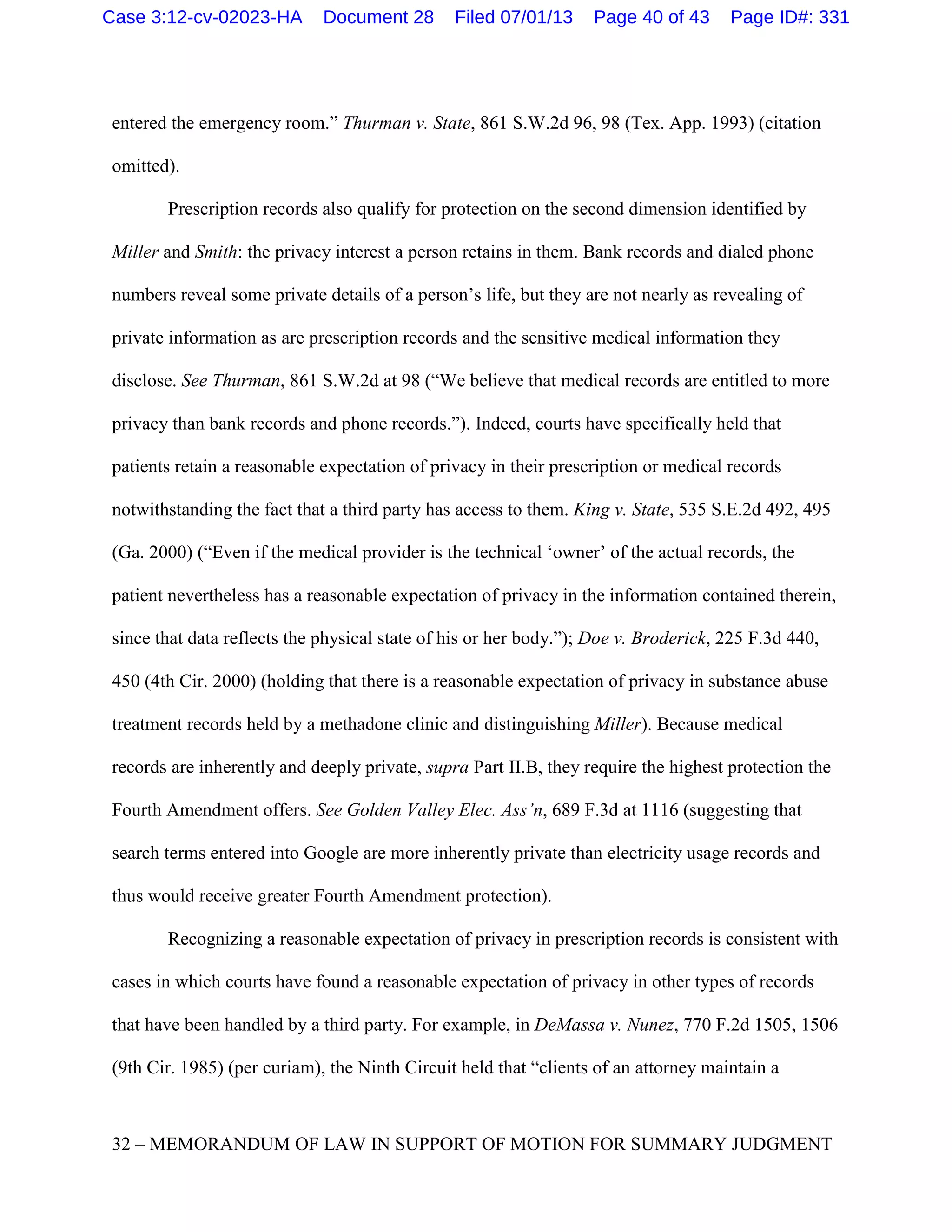
![legitimate expectation of privacy in their client files.” The court identified the source of this
reasonable expectation of privacy “in federal and state statutes, in codes of professional
responsibility, under common law, and in the United States Constitution.” Id. at 1506–07. The
fact that the files were in the possession of the attorney, not the client, did not undermine the
protections of the Fourth Amendment. Id. at 1507; accord United States v. Knoll, 16 F.3d 1313,
1321 (2d Cir. 1994) (“[T]he protection of the Fourth Amendment extends to those papers that a
person leaves with his or her lawyer.”); see also United States v. Warshak, 631 F.3d 266, 285
(6th Cir. 2010) (holding that there is a reasonable expectation of privacy in the contents of emails
even though email is sent through an internet service provider’s servers). Likewise, that
Plaintiffs-Intervenors’ prescription records are in the PDMP’s database does not vitiate the
otherwise-reasonable expectation of privacy in them.
In light of the high expectation of privacy in prescription records and the medical
information they reveal, supra Part II.B, Miller and Smith do not apply to the medical records at
issue here.
CONCLUSION
For the foregoing reasons, the Court should grant Plaintiffs-Intervenors’ motion for
summary judgment.
Dated: July 1, 2013 Respectfully submitted,
/s/ Nathan Freed Wessler
Nathan F. Wessler (pro hac vice)
Ben Wizner (pro hac vice)
American Civil Liberties Union Foundation
125 Broad Street, 18th Floor
New York, NY 10004
Tel.: (212) 549-2500
Fax: (212) 549-2654
Kevin Díaz (OSB No. 970480)
33 – MEMORANDUM OF LAW IN SUPPORT OF MOTION FOR SUMMARY JUDGMENT
Case 3:12-cv-02023-HA Document 28 Filed 07/01/13 Page 41 of 43 Page ID#: 332](https://image.slidesharecdn.com/darrenchakeracluprivacy-160724182329/75/ACLU-Darren-Chaker-Privacy-41-2048.jpg)

